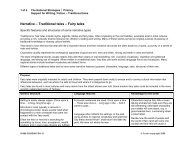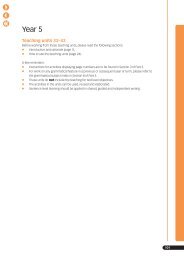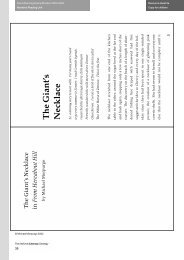Create successful ePaper yourself
Turn your PDF publications into a flip-book with our unique Google optimized e-Paper software.
Revising science topics for their national tests, this Y6 class uses physical theatre whenever possible.<br />
1<br />
In a lesson about solids, liquids and<br />
gases, groups of children simulate<br />
the activity of molecules as a solid<br />
changes to a liquid and a liquid to a<br />
gas.<br />
department for<br />
education and skills<br />
3<br />
Meanwhile, in Literacy Hour,<br />
they study examples of<br />
explanation text,<br />
concentrating on<br />
� integration of visual and<br />
verbal information<br />
� characteristics of<br />
explanatory language,<br />
especially the use of<br />
technical terms and causal<br />
connectives, e.g. because,<br />
so.<br />
4<br />
2<br />
In independent writing, the pupils write an explanatory text based<br />
on the skeleton flowchart.<br />
SOLIDS, LIQUIDS AND GASES<br />
In pairs, pupils devise<br />
flowcharts to explain the<br />
changes. The class<br />
discusses successful<br />
examples and produces<br />
a class flowchart.<br />
Materials are all made of tiny particles which are called molecules. When a material is a<br />
solid, the molecules are very close together so they do not move about. This means a solid keeps<br />
its shape and you can hold it, cut it or shape it.<br />
Sometimes solids (like ice, wax or iron) can be changed into liquids by heating them. Heat<br />
makes the molecules more spaced out, so they can move about a bit. They are still close enough<br />
together to obey gravity, so they flow downwards. If you put liquid in a container, it flows into the<br />
shape of the container, but the top surface stays level.<br />
All liquids (e.g. water) change into gases when you heat them, because the heat makes the<br />
molecules move far apart. They move about quickly in every direction, and they can be very hard to<br />
control. Gases are invisible.<br />
If you cool these gases down again, they will be liquids. If you cool the liquids down they<br />
go back to solids.








